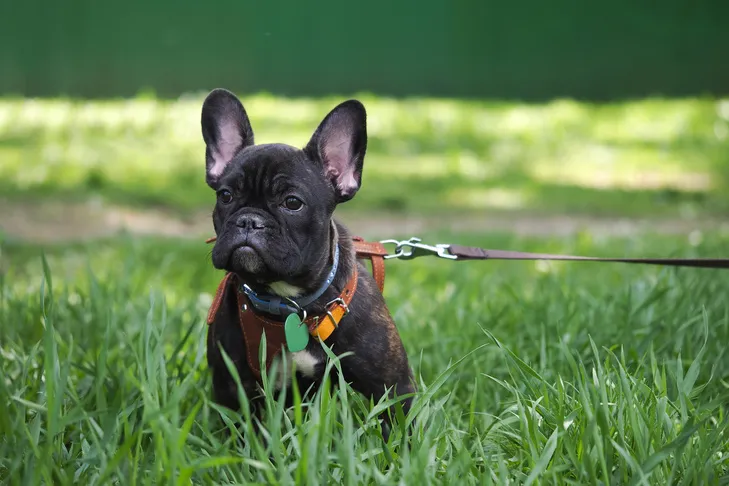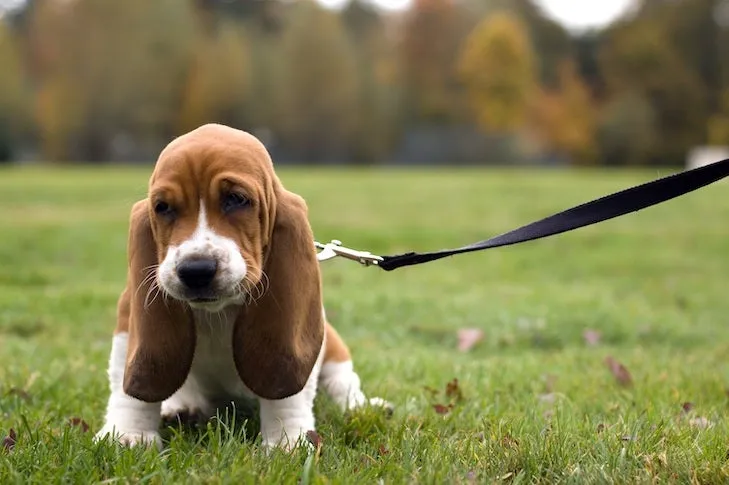Many new puppy owners assume that their furry companions instinctively know how to walk politely on a leash. However, much like learning basic commands, mastering the leash is a crucial skill that needs to be taught. This foundational training is invaluable, ensuring enjoyable and safe outings for both you and your puppy throughout their life. Fortunately, renowned dog training expert and AKC Family Dog columnist, Kathy Santo, offers expert guidance on the best way to leash train a puppy effectively and positively. With patience and consistency, you can transform chaotic walks into pleasant strolls.
Laying the Foundation: Essential Steps for Puppy Leash Training
Establishing a strong foundation is key to successful puppy leash training. These initial steps focus on positive association and clear communication, setting your puppy up for a lifetime of comfortable walks.
Introducing the Collar/Harness and Leash
The very first step in leash training your puppy is to help them become comfortable with their new gear. Start by introducing them to a collar or harness and a leash in a positive way. Let them wear these items for brief periods while inside the house, especially during playtime or treat sessions. The goal is for your puppy to associate their collar-and-leash time with fun and rewards, making it an exciting part of their day.
Teaching a Recall Cue
A reliable recall cue is fundamental for managing your puppy’s attention, especially during leash training. Introduce a consistent sound that signals “Food is coming!” This could be a clicker, a specific word like “yes,” or even a tongue cluck. To teach this, find a quiet, distraction-free space with your puppy wearing their collar and leash. Make the chosen sound. The instant your puppy turns their head or looks at you, reward them with a tasty treat. Repeat this several times. Soon, your puppy will not only look at you but actively come towards you when they hear the cue, anticipating a reward. This positive reinforcement method is a cornerstone of the Best Way To Leash Train A Puppy.
Encouraging Your Puppy to Come to You
Once your puppy understands the cue, expand on it by encouraging them to follow you. As they respond to your cue and head your way, take a few steps backward while they are still approaching. Reward them enthusiastically once they reach you. Continue this progression, gradually increasing the number of steps you walk together after the cue, always ending with a reward. Remember that puppies have short attention spans. Keep your training sessions brief and engaging, always finishing while your puppy is still eager for more, rather than when they are tired or frustrated. This approach helps maintain their enthusiasm for learning how to train a dog to walk off leash later on.
 French bulldog puppy in a harness sitting in tall green grass on a leash for a walk.
French bulldog puppy in a harness sitting in tall green grass on a leash for a walk.
Practicing Indoors
With your puppy now understanding the recall cue and accustomed to the leash, it’s time to practice walking indoors. Choose a room with minimal distractions. The sensation and sight of the leash around them will still be a significant challenge. Continue to offer treats and praise as your puppy learns to walk a few steps with you while on the leash. This controlled environment allows them to focus on the task without the overwhelming stimuli of the outside world.
Venturing Outdoors
Finally, your puppy is ready to explore the great outdoors with you! This stage presents new challenges due to the myriad of sounds, smells, and sights that will naturally intrigue your puppy. Be patient and keep these initial outdoor walks short. The key here is proactive management. While walking, if you notice your puppy is about to lunge towards something or become distracted (your constant observation will help you anticipate this), use your cue sound and take a few steps away from the tempting object. Reward them immediately with a treat for redirecting their attention and following you. This teaches them that focusing on you is more rewarding than the distraction.
 Basset Hound puppy sitting in the grass on lead.
Basset Hound puppy sitting in the grass on lead.
Troubleshooting Common Leash Training Challenges
Even with solid foundational training, your puppy may encounter various challenges as they grow, visit new places, and face different distractions. The goal is to teach them loose-leash walking, which is far more pleasant for both of you and essential for passing tests like the Canine Good Citizen. Here are some expert tips from the AKC GoodDog! Helpline for addressing common leash training issues.
What to Do If Your Puppy Pulls
One of the most common issues is a puppy pulling on the leash. If your dog starts pulling ahead or in another direction, immediately stop and become “a tree.” Stand completely still and refuse to move until your dog relaxes the leash and returns their attention to you. Avoid yanking or jerking the leash, or dragging your dog. This method teaches them that pulling gets them nowhere, while a loose leash allows forward movement. For persistent pullers, alternative training tools like front-hook harnesses and head halters can be incredibly helpful in getting your dog not to pull on lead.
Managing Puppy Lunging
If your dog tends to lunge at other dogs, cars, skateboarders, or other stimuli during walks, proactive intervention is crucial. Before they have a chance to lunge, try to redirect their attention with a treat. Increase the distance between your dog and the trigger whenever possible. Stay vigilant and be prepared to act before the object of their frustration or excitement gets too close. While this behavior can be more common in herding breeds, any dog can be startled or overstimulated by new or exciting things. Consistent redirection and positive reinforcement are vital components of the best way to leash train a puppy and prevent lunging.
Addressing Puppy Barking
Some dogs develop a habit of barking excessively at other dogs or people while on walks. Often, this behavior stems from insufficient exercise or mental stimulation. Ensure your dog receives the appropriate amount of physical activity and mental engagement for their age and breed. If barking persists, employ a similar strategy as you would for lunging: create distance from the trigger and offer treats before your dog begins to bark. Over time, your dog will learn to associate seeing other dogs with turning their attention back to you for a reward, rather than barking.
Gradually, you will be able to reduce the frequency of treats and the amount of active troubleshooting needed during walks. However, it’s always a good idea to keep some treats on hand to randomly reinforce excellent leash-walking behavior.
Conclusion
Successfully leash training your puppy is a rewarding journey that builds a stronger bond and ensures pleasant, safe adventures together. By following these structured steps—from initial collar introduction and cue training to practicing indoors and tackling outdoor distractions—you equip your puppy with essential skills. Remember to be patient, consistent, and always use positive reinforcement methods. Addressing common challenges like pulling, lunging, and barking with proactive strategies will pave the way for a happy, well-behaved walking companion. If you find yourself needing extra support, expert help is available. Training your dog can be challenging without expert guidance, and resources like the AKC GoodDog! Helpline connect you with professional trainers who offer unlimited, individualized advice on everything from house-training to behavioral issues, ensuring you’re always supported in the best way to leash train a puppy and beyond.
